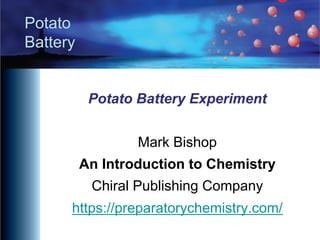
Potato_Battery.pdf
- 1. Potato Battery Potato Battery Experiment Mark Bishop An Introduction to Chemistry Chiral Publishing Company https://preparatorychemistry.com/
- 2. Goals of this Video • Describe how oxidation-reduction reactions can be used to make batteries, which are perhaps more correctly called voltaic cells, • to show you how you could make a battery using a potato, • To show you how you can measure voltage and current, • to show you how you can connect two voltaic cells in series or in parallel and how this affects voltage and current, • and to provide you with some data that can be used to complete a potato battery lab analysis.
- 3. Voltaic Cell or Battery • A voltaic cell is a system in which two half-reactions for an oxidation- reduction reaction are separated, allowing the electrons transferred in the reaction to be passed through a wire. • A voltaic cell is commonly called a battery.
- 4. Oxidation-Reduction Reaction Zn(s) + CuSO4(aq) ® ZnSO4(aq) + Cu(s) Zn(s) + Cu2+(aq) ® Zn2+(aq) + Cu(s) oxidation: Zn(s) ® Zn2+(aq) + 2e− reduction: Cu2+(aq) + 2e− ® Cu(s) https://preparatorychemistry.com/Zn_CuSO4_Canvas.html
- 5. Voltaic Cell
- 6. Potato Battery • The potato provides the electrolyte and one of the reactants. • Zinc metal provides that anode electrode. • Copper metal provides the cathode electrode. • We will measure voltage and current with a multimeter.
- 7. Potato Battery Anode oxidation: Zn(s) ® Zn2+(aq) + 2e− Cathode reduction: 2H3O+(aq) + 2e− ® H2(g) + 2H2O(l) Overall reaction: Zn(s) + 2H3O+(aq) ® Zn2+(aq) + H2(g) + 2H2O(l)
- 9. Voltage and Current • The physicists would tell you that electromotive force (emf) and voltage are not exactly the same thing, but because the units of emf are volts, it is common to call the cell emf voltage. • Current is the net flow of electric charge through a region in coulombs per second or amperes. In our case, current describes the net flow of charge in coulombs per second or amperes as electrons move from the anode to the cathode in our voltaic cell.
- 10. Potato Battery: Voltage • To measure voltage for direct current, we twist the dial counterclockwise to “2”. • We put the black wire from the zinc anode electrode in the bottom hole that says “COM” next to it. • We put the red wire from the copper cathode electrode in the middle hole with the thicker red circle around it.
- 11. Potato Battery: Current • To measure current, we twist the dial clockwise to “2m”. • We put the black wire from the zinc anode electrode in the bottom hole that says “COM” next to it. • We put the red wire from the copper cathode electrode in the top hole with the thinner red circle around it.
- 12. Data Sheet You can find the data sheet for this experiment at the following web address. You will want it in front of you for the next part of this video. https://preparatorychemistry.com/Potato_Battery_Data_Sheet.htm
- 13. Cell emf and reducing agents • When a substance is oxidized it loses electrons, making it possible for something else to gain electrons and be reduced. Therefore, we call the substance that is oxidized the reducing agent. • In our experiment, the zinc, tin, and magnesium all acted as the anode in our voltaic cells, so they all have a greater tendency to lose electrons and act as reducing agents. • The measured cell emf, εcell, (or voltage) is the sum of the oxidation emf, εox, (from zinc, tin, or magnesium) and the reduction emf, εred, (from the copper). εcell = εox + εred
- 14. Cell emf and reducing agents εcell = εox + εred • Because copper is the cathode electrode in all of our voltaic cells, the reduction emf is constant. • Therefore, a higher cell emf reflects a higher oxidation emf, εox, for the metal (zinc, tin, or magnesium), which indicates a great tendency to lose electrons, making the metal a better reducing agent. • You will use this to answer one of the questions on your data sheet.
- 15. Potato Batteries in Series: Voltage • Connect the anode electrode (Zn) of one voltaic cell to the cathode electrode (Cu) of another voltaic cell. • Connect the anode electrode (Zn) from one voltaic cell to the meter, and the cathode electrode (Cu) from the other voltaic cell to the meter. • Two voltages in the circuit, so voltage increases.
- 16. Potato Batteries in Series: Current • The electrons moving from the zinc in the potato on the right to the copper in the potato on the left, do not go through the meter or through anything else this circuit is meant to power, so there is only one zinc delivering electrons through the meter to one copper. • Therefore, when voltaic cells are connected in series, the current measured is about the same as it would be for each of the separate voltaic cells.
- 17. Potato Batteries in Parallel: Voltage • Connect anode electrode (Zn) to anode electrode (Zn). • Connect cathode electrode (Cu) to cathode electrode (Cu). • Connect anode electrode (Zn) to meter. • Connect cathode electrode (Cu) from the same voltaic cell to meter. • There is only one voltage in the circuit, so voltage is about the same as the separate potato batteries.
- 18. Potato Battery: Series Current • Because the two zinc electrodes are connected, they can both provide electrons that can move through the meter or anything else that the voltaic cells are powering. • Because the two copper electrodes are connected, they can both accept electrons that have moved through the meter or anything else that the voltaic cells are powering. • Therefore, more electrons move through the meter per second, which means that the current increases.